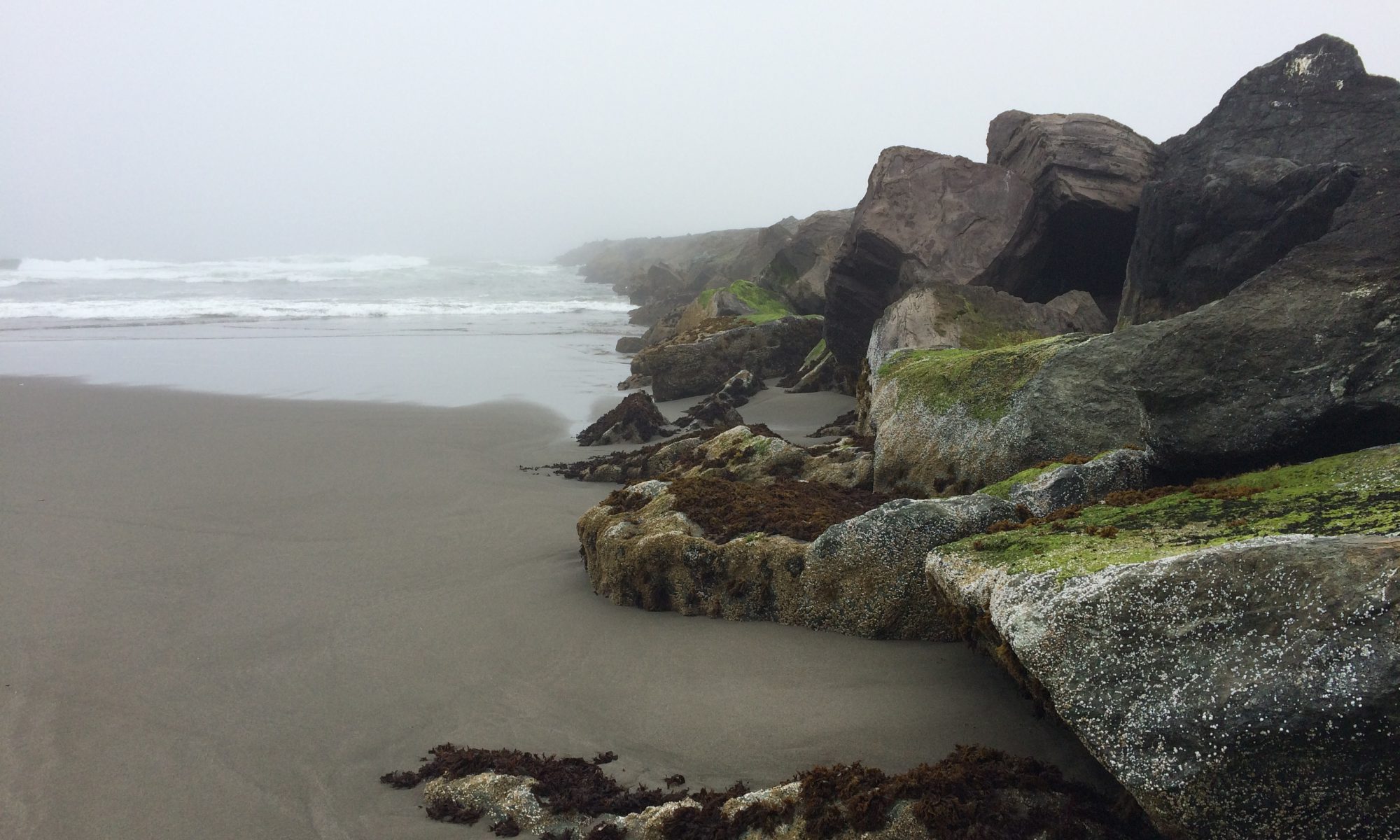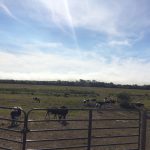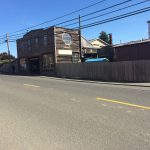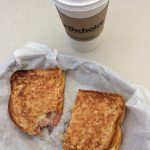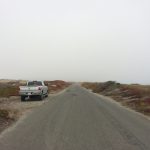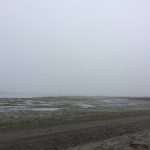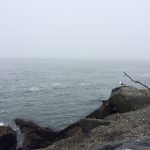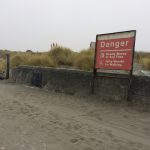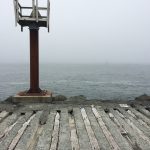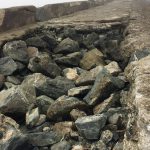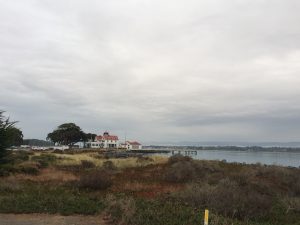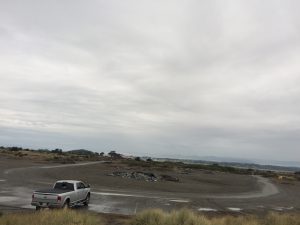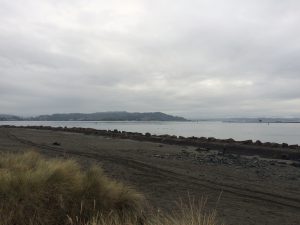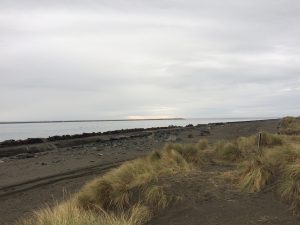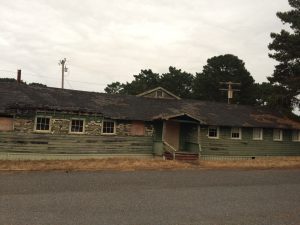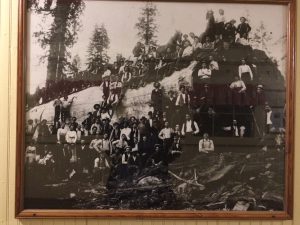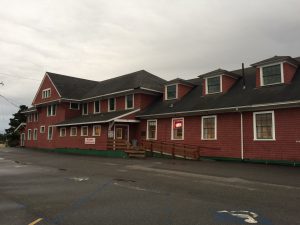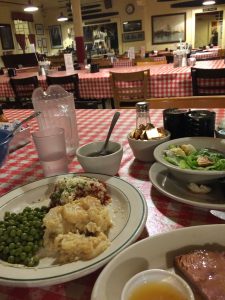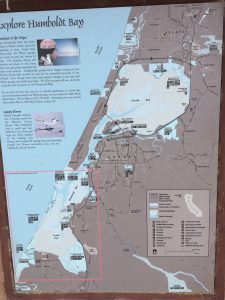
Humboldt Bay is big – 16,000 acres. The bay’s port at Eureka is the only protected deep water harbor between San Francisco and Seattle, so Humboldt Bay is a pretty important place from both an economic and ecology perspective. If you visit Humboldt Bay today, you’ll find three distinct zones: South, North and Central.
The North and South consist of long barrier sand spits barely connected to the mainland. The Central section is the protected harbor, divided between mudflats teeming with wildlife and the City of Eureka, Humboldt County seat. Most of the central bay is private property. It’s the two spits that are the most accessible to the public as recreation areas, thanks to access roads the Corps of Engineers put it when they built a jetty at the end of each spit in 1890. The jetties were needed to stabilize the harbor entrance, which until then involved a risky transit over ever-changing sandbars.
Though the North and South jetties are only a half mile apart at the mouth of the bay, it will take you an hour to drive from one to the other by car. From Fortuna, the route to the South Jetty takes you through the dairy community of Loleta. You wouldn’t think a tiny town like Loleta has much claim to fame, but cows know about the place. Never too hot or cold, with acres of lush grass watered by the Eel River delta, Loleta is Holstein Heaven.
Loleta Cheese Factory
No trip through the area is complete without a stop at the cheese factory. A self-proclaimed artisan cheese maker, Loleta offers a wider selection of varieties than their bigger, better-known cousin creamery in Tillamook. If Tillamook is the Disney of cheese, Loleta is the local theater; there’s a lot of talent there, but get 50 miles away and they’ve probably never heard of it.
Is it a Cult or Not? Chapter One – The Lighthouse Ranch
From Loleta, you continue on past the tiny 88 acre Wiyot reservation to the site of the former Lighthouse Ranch on Table Bluff overlooking the South spit. My grandfather always referred to the place as “the hippie commune”, and didn’t have much more to say on the subject. That in itself was telling, as my grandparents were conservative people who took a dim view of the “Dirty Hippies” who they believed were ruining Humboldt. Looking back, I would have expected outright condemnation, but their reaction was something more like suspicious disinterest. I suspect the reason was the group was affiliated with a church in Eureka.
This poses the question: What makes a group a cult? Is it following unpopular religious beliefs? Requiring initiates to hand over all their money and property? Raising funds that are then squandered by the leaders? Isolating members from outside friends and relatives? Mistreating members mentally and/or physically?
Everyone has to choose where they draw the line on the continuum that stretches from the Vatican to the Manson Family. In the case of the Lighthouse Ranch, the neighbors seemed to tolerate the place, framing the operation as a sort of halfway house for transitioning shiftless hippies back into the mainstream community.
The location had an interesting history – an 1892 lighthouse became a coast watcher station in WWII, then the light was automated and the station abandoned in 1953, with the Coast Guard eventually moving the light to the end of the South Jetty. By the sixties the buildings were in rough shape, and were occupied by people that have been labeled at one time or another as bums, hippies, homeless or criminals. Supposedly there was even an incident where the Hell’s Angels caused trouble there.
By the Summer of Love, the population on Table Bluff had begun to crystallize into a group of young people who found the San Francisco free love and hard drugs scene a bit of a step too far, but didn’t want to move back home with the parents and get a job at the mill. As often happens when a bunch of directionless young seekers gather together, a charismatic spiritual leader appears with a message and a rule book. This time it was an evangelical preacher with backing from a Eureka real estate developer.
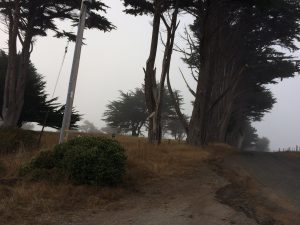
If you want to learn more about Lighthouse Ranch, you can watch a video, read the Wikipedia page or this article. My personal take is a line from CW McCall’s CB radio hit Convoy – “eleven long-haired Friends of Jesus in a chartreuse microbus.” The Jesus People movement was essentially benign; they collected a lot of lost kids and gave them a way to make sense of the universe and bring order to their lives. Eventually the commune dwindled and disappeared as the supply of hippies was displaced by yuppies who had no interest in planting potatoes and making their own clothes.
So was Lighthouse Ranch a cult? I guess you have to decide for yourself. If you figure it out, let me know.
South Humboldt Bay Spit & Jetty
We always called it “the South Jetty”, perhaps because my grandmother thought the word “spit” was rude. Funny really, since we usually didn’t visit the jetty itself. Grandpa Ted was a great sportsman, and Humboldt Bay was his playground. I learned to shoot out there in those hummocks, plinking Olympia beer cans with an ancient 22 rifle with my mother’s name engraved in the stock. By the age of eleven I was driving Ted’s big GMC Sierra over the sandy trails, amusing my grandfather greatly when I would get stuck and we’d have to get out and let some air out of the tires to regain traction.
We dug clams on the mudflats and trapped crabs in the bay. My job was baiting the crab pots. Ted would buy five dollar’s worth of snapper heads at the cannery and my job was to chop the well-aged fish into bait chunks. A disgusting job, perfect to give the kid. How else could I learn fish eyeballs explode if you hit them with a hatchet?
No matter how smelly the task or uncomfortable the weather, I loved every second of my time on the South Jetty with my grandfather. Back in the Midwest I was the middle child with glasses, braces and a weight problem. On Humboldt Bay, I was a guy who shot guns, drove trucks off road and went fishing with the man who knew everything, could fix anything and treated me like any other fishing buddy.
Yes, this fogbound strip of sand is Hallowed Ground.
North Jetty/Samoa
The North Jetty is attached to the Samoa peninsula. To get to Samoa, you have to drive into the city of Eureka and cross a bridge. Unlike the South Spit which is all public land, much of Samoa is private property. The public land is the southernmost part, which was once a Naval Auxiliary Air Station. Blimps were based here just like in Tillamook, but Samoa had no giant hangers for them, just a tarmac and mooring towers.
What’s left of the old Navy facility is now a Coast Guard Station. The North Jetty was much farther from Fortuna than the South, and offered fewer outdoor recreation opportunities, so we only came here rarely when I was a kid, with one big exception.
Samoa Cookhouse
When lumber was king in Humboldt County, Samoa was one of the centers of activity. Situated directly on the bay, Samoa was an ideal location for the Hammond Lumber Company Town. For fifty years loggers cut up and shipped the big redwood trees from here. The lumber industry may not be entirely dead here, but it is certainly in a deep coma. No mills are left on Samoa, but one tradition of the lumber camp lives on in the Samoa Cookhouse. As cowboys had the Chuckwagon, lumberjacks had the Cookhouse. In the cookhouse, long tables were loaded down with hearty food and lots of hot coffee to feed the men who performed the hard, dangerous work of cutting three hundred foot tall trees.
Samoa Cookhouse is a set menu, one-price, unlimited second helping place, served family style at those same long tables. A small museum of logging equipment sits off to one end of and the walls are covered with old photos and mementos from bygone days. This was my favorite place to eat as a kid, and they are still serving up the same basic, homestyle food served in giant quantities three times a day. I came in on a Monday night a couple hours before closing, and the place was nearly empty. I avoid all-you-can-eat places these days, but it was my big splurge for my 56th birthday.
That day the bill of fare was:
- chicken vegetable soup
- sourdough bread
- chopped salad
- three bean salad
- potatoes au gratin
- green peas
- chicken parmesan
- baked ham
- spice cake
And no, I couldn’t eat it all and I did not ask for seconds!
